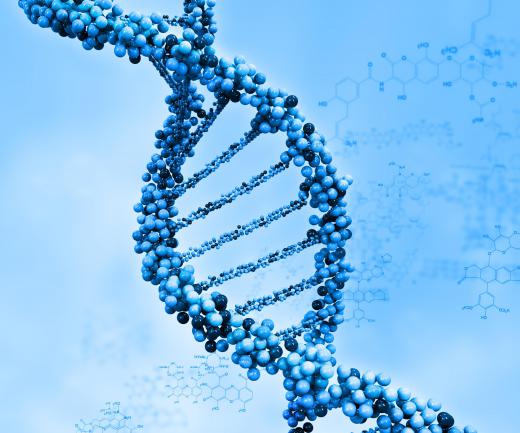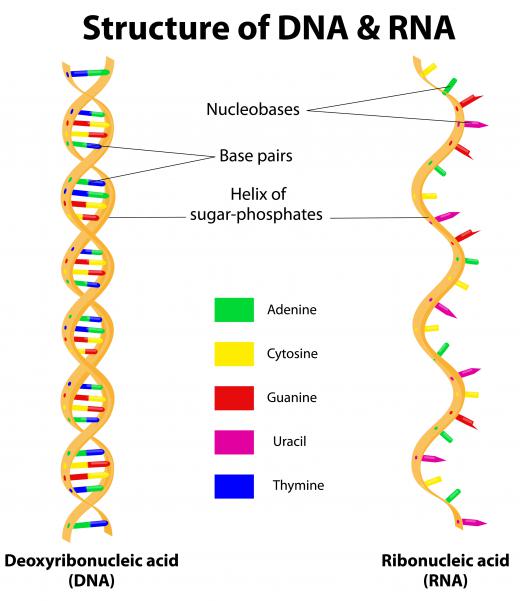What are Nucleotides?
 Mary McMahon
Mary McMahon
Nucleotides are molecules which form a critical part of RNA and DNA, making them important for every living organism on Earth. These special molecules are also involved in enzyme reactions in the body, production of chemical energy, and cell signaling. A number of researchers work with nucleotides, identifying different types and their functions, and studying their chemical structure.
Three separate molecules come together to make a nucleotide. The first is a base which can be a purine or a pyrimidine compound. The base attaches to a pentose sugar, a sugar which has five carbon atoms, to create a nucleoside. The nucleoside in turn joins with a phosphate group, creating a nucleotide. In the case of RNA, the sugar is a ribose sugar, creating a ribonucleotide, and in DNA, the sugar is a deoxyribose sugar, creating a deoxyribonucleotide.

When nucleotides link together, they form nucleic acid, a polymer. In DNA and RNA, chemical bonds create long chains of nucleic acids which are joined in a famous ladder-like shape. The chemical structure of each nucleotide determines which nucleotide it can bond to across the ladder, an important trait which determines how DNA and RNA can be assembled. Each set of nucleotides which makes up a rung in the ladder is known as a base pair, and an individual organism can have billions of base pairs in its genetic code.

Nucleotides, along with amino acids, are sometimes referred to as the building blocks of life, because they provide the basis of the genetic code. In the form of DNA, nucleic acids are capable of undergoing a process known as transcription to create an RNA copy, and the RNA copy directs the production of various proteins by the body. These proteins are involved in daily biochemical processes, and also in the underlying structure of an organism, with genes to produce proteins activating as soon as an egg becomes fertilized and cells start dividing.

Research on nucleotides is concerned with identifying the various nucleotides present in the body and what they do, and in looking at variations in nucleotides which can be linked with pathologies and various natural phenomena. For example, errors in the production of nucleotides can lead to genetic mutations, caused by interference in the copying of DNA which results in damage to various areas of the genetic code. Many researchers use sophisticated computer modeling systems to make models of the nucleotides they work with.
AS FEATURED ON:
AS FEATURED ON:













Discussion Comments
If you linked five nucleotides together how many water molecules would you get?
@aishia - You make a good point about albinism...
Another interesting thing to note with that whole "the body can notice its odd nucleotide production and fix it" thing is that albinism is incurable. People who are born with albinism stay that way their entire lives. To me, that makes the nucleotide differences more of a permanent thing.
If you ran nucleotide sequencing on the DNA of the non-albino child of two albino parents before the child was born, I would be willing to bet that the child's nucleotides never had any traits of albinism to begin with.
What I'm saying is, I don't think the baby could inherit its parents nucleotide sequences for albino and then "fix" them during the formative stages, but rather the baby eitehr has albino nucleotide sequences or has non-albino nucleotide sequences and stays whichever way it ends up.
If it was the way that you were saying -- with the baby originally having the albino nucleotides and then "correcting" them -- then conceivably, a "cure" to albinism would be possible by manipulating a person's nucleotides. In that speculative future, I'll bet doctors would test the unborn baby for albinism and correct it before it barely even had a chance to start.
@VivAnne - I can't answer all of those questions, but that last one I'm pretty sure about. Since the article said that the production of nucleotides going wrong somehow can cause genetic mutations, I can safely say that yes, nucleotide differences can visibly affect a person's appearance.
In particular, I believe that nucleotides are responsible for why some human beings are born with albinism -- a genetic mutation and inherited condition that causes a person to be born with no pigment in their body.
Individuals with albinism have white hair, pale somewhat translucent skin, and their eyes look pale blue or pink since the only visible color in them is from the blood vessels in the backs of the eyes seen through the translucent colorless corneas.
What I find fascinating is that albinism can be inherited. That means that it isn't so much an error in the production of the nucleotides as an actual mutation that causes them to be made a different way from that point onward.
Since albinism can't be inherited one hundred percent -- it can skip generations, and albino parents can have non-albino children -- I think it stands to reason that it's possible for the body to "notice" the nucleotides are being produced differently and to correct it while the child is in its formative stages.
Thanks for this article. For the first time ever, I now understand whatI'm looking at when I view that famous DNA strand that everybody uses as an image for DNA anything. The things between the "ladder rungs" are in fact bunches of grouped together nucleotides!
So, the article says that the chemical structure of each nucleotide determines which other nucleotides it can combine with using a "rung" and become a base pair together with, right? I know there must be some difference for whether one type can bond with another, but I'm curious how many different combinations are possible.
Can one nucleotide type bond with more than one other type? Can DNA nucleotides be rearranged, added or lost after they've already combined into base pairs? For that matter, are base pairs already formed attached, or do they combine at some point?
This is really thought-provoking stuff. I wonder if a few rearrangements of somebody's nucleotides could change something noticeable, like their eye color?
Man, what a fascinating subject! Reading about the structure of DNA makes me wish I had more of a head for mathematical stuff so that I could get into a DNA- and science-related career.
I think breaking the research down to the level of nucleotides and amino acids is a great way to learn about how human beings even exist. I mean, look at us -- we're pretty spectacular creatures! Human beings have many amazing attributes that nothing else has -- particularly how our bodies seem perfectly designed for many of the things that we encounter.
By breaking down the study of such a fantastically complicated creature into the smallest units possible -- atoms and molecules, then nucleotides and amino acids -- I think it's basically the same as splitting an enormous meal into manageable-sized bites.
Seeing as how we still don't even fully understand nucleotides, though, I'd say we have a long way to go. If not for the math, I'd be helping in those advancements.
Post your comments